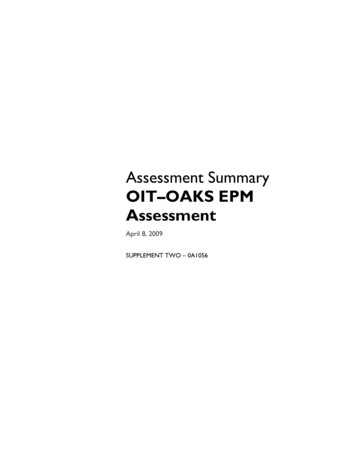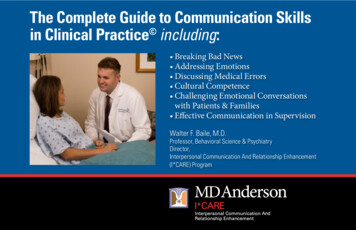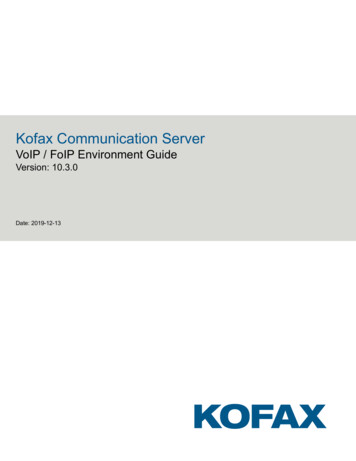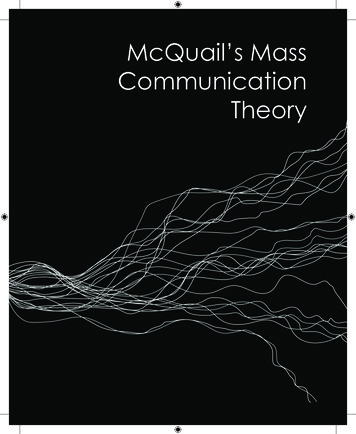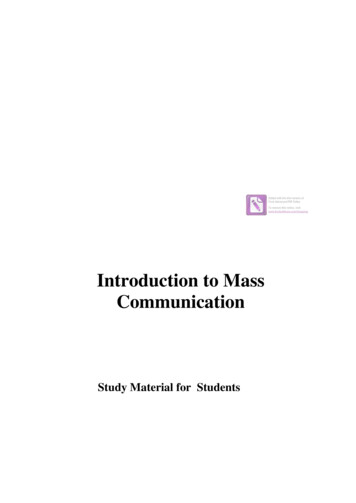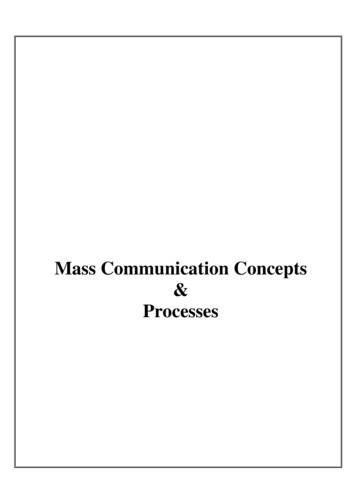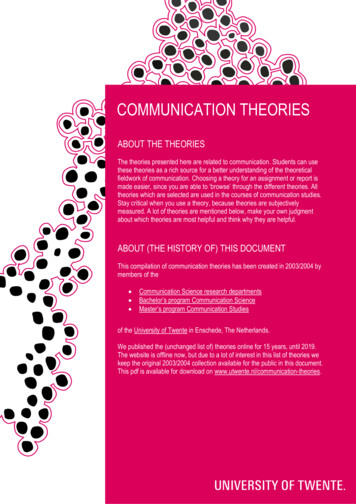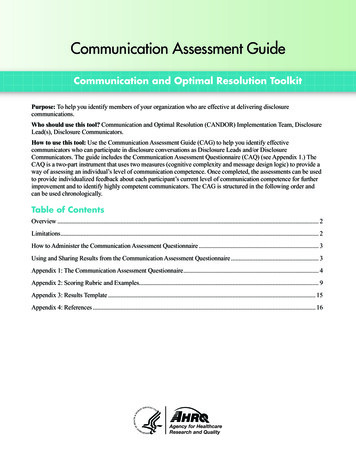
Transcription
Communication Assessment GuideCommunication and Optimal Resolution ToolkitPurpose: To help you identify members of your organization who are effective at delivering disclosurecommunications.Who should use this tool? Communication and Optimal Resolution (CANDOR) Implementation Team, DisclosureLead(s), Disclosure Communicators.How to use this tool: Use the Communication Assessment Guide (CAG) to help you identify effectivecommunicators who can participate in disclosure conversations as Disclosure Leads and/or DisclosureCommunicators. The guide includes the Communication Assessment Questionnaire (CAQ) (see Appendix 1.) TheCAQ is a two-part instrument that uses two measures (cognitive complexity and message design logic) to provide away of assessing an individual’s level of communication competence. Once completed, the assessments can be usedto provide individualized feedback about each participant’s current level of communication competence for furtherimprovement and to identify highly competent communicators. The CAG is structured in the following order andcan be used chronologically.Table of ContentsOverview. 2Limitations. 2How to Administer the Communication Assessment Questionnaire. 3Using and Sharing Results from the Communication Assessment Questionnaire. 3Appendix 1: The Communication Assessment Questionnaire. 4Appendix 2: Scoring Rubric and Examples. 9Appendix 3: Results Template. 15Appendix 4: References. 16
OverviewCommunication is at the heart of the CANDOR process. Effective communicators who participate in conversationswith patients, families, and caregivers following an adverse event must demonstrate the following characteristics andcompetencies consistently and naturally. Individuals who are effective Disclosure Leads or Communicators will: Demonstrate empathy, sincerity, and honesty Demonstrate active listening skills Demonstrate patience during stressful situations Demonstrate tact and diplomacy Demonstrate emotional maturity and self-awareness/intelligence by withstanding anger, criticism, accusations,blame, combative, or defensive behavior without taking criticism personally Adapt non-verbal expressions and body language to the situation Speak without using medical jargon and non-technical language Focus entirely on the patient’s and family’s interests Understand when to seek additional support and help during a conversation with a patient and/or familyIndividuals who are effective Disclosure Leads or Communicators will be experienced members of the organizationwho portray a professional demeanor and authority. These individuals should demonstrate: Experience in communicating with patients and families about bad news, complaints, and grievances Understanding that s/he speaks for the organization, not an individual unit or department, and thus conveys a“we” message, avoiding criticism or blame of other individuals or departments Sufficient clinical knowledge and experience to answer relevant questions Familiarity with the organization’s risk, safety, claims, and quality operations An understanding of the individual and systemic bases of patient harm Genuine professional commitment to the principles of just culture and the CANDOR processMost health care team members exhibit some of the skills and competencies listed above. Only those team memberswho demonstrate all of the skills and competencies should be involved in delivering communication about adverseevents to patients, families, and caregivers. Strong communicators are usually easily identifiable; however, somemight not yet generally be known.LimitationsWhen identifying effective communicators, the results of the CAQ should be used in conjunction with all otheravailable sources of information about staff members’ communication skills, including personal experience,recommendations, performance reviews, professional experience, position within the organization, and patientsatisfaction scores. The CAQ is not meant to be used as the sole basis for identifying candidates for Disclosure Leadsor Communicators. The number of people selected for this role will depend on the size of the organization and theresources available for training.2 – Communication Assessment Guide
How to Administer the Communication Assessment QuestionnaireThe CAQ can be uploaded into an e-survey or by administering paper-based forms. Members of the CANDOR Teamcan administer this instrument at their discretion when evaluating potential members of the Disclosure Team. Thescores are combined for both assessments to yield one final score.Part I: Role Impression TasksThe cognitive complexity assessment is the first task, and it requires the participant to think of two people that heor she knows well on a personal level: one liked, and one disliked. The participant must then describe first the likedand then the disliked person in as much detail as possible, ignoring physical characteristics and focusing instead onthe person’s character, personality, behavior, etc. Participants are instructed to take no more than 5 minutes on eachimpression. These impressions are then scored in terms of their complexity using a standard scoring procedure. Theresult is a cognitive complexity score for each participant.To assess a cognitive complexity score, simply count the number of unique descriptors used in the impressions of theliked and the disliked people. The total number of unique adjectives used, summed across the liked and the dislikedimpressions, will yield the cognitive complexity score for that person. Sometimes it is not obvious where to draw theboundary, or whether a description should count as one or two concepts. The rule is to err on the side of more ratherthan fewer concepts; if in doubt, please count the additional concept.Part II: Role Scenario TasksThe second part of the CAQ identifies messages that reflect the highest level of communication skill. Message designrefers to the process that people use to perceive the relevant goals in a situation and to then convey messages thatwill achieve those goals.1 The type of message design someone employs will show how effectively a person relayshis or her intended message.To make this assessment, ask each participant to read two hypothetical communication scenarios (a group projectscenario and a disclosure scenario) and write down exactly what they would say in that situation. Then apply astandardized scoring procedure2 to the messages to identify participants with the highest level of communicationskill.Using and Sharing Results from the Communication AssessmentQuestionnaireData Preparation and LogisticsTo prevent scores on one section of the assessment from influencing scores on another section of the assessment,review and score all responses for Part I separately from Part II. Then score as described below, and enter the scoresinto the spreadsheet for further analysis.Reporting Feedback to ParticipantsOnce all of the responses are scored, rank all of the participants from highest to lowest based on their scores for PartsI and II, respectively. A template for sharing responses with participants is found in Appendix 3.Research indicates that there are at least three “message design logics” commonly used by communicators, and thesecorrespond to progressively higher levels of communication competence. From least to most competent, these are the expressive,conventional and rhetorical message design logics.1The overall Approach to Scoring the Group Project and Harm Disclosure Situations is very similar to scoring CognitiveComplexity. Count concepts individually, and compare written responses with the examples noted in Appendix 2 to identify whattype of message design logic participants will exhibit.2Communication Assessment Guide – 3
AppendixesAppendix 1: The Communication Assessment Questionnaire1. Your Name:The purpose of this questionnaire is to help us understand how you approach interpersonal communication. Thequestionnaire has two parts. The first part asks you to describe two people whom you know well. The secondpart asks you what you would say in two separate interpersonal communications.Part 1: Role Impression TasksWe want to learn how people describe others whom they know. In your own words, indicate the characteristicsthat a set of individuals have in common and those they do not share.Spend a few moments looking over this list, mentally comparing and contrasting the people you have inmind for each category. Think of their habits, their beliefs, their mannerisms, their relations to others, anycharacteristics they have that you might use to describe them to other people.Please choose a real person that fits each of the two different categories below. In the blank space beside eachcategory below, please write the initials, nicknames, or some other identifying symbol for a person you knowwho fits into that category. Be sure to use a different person for each category.2. A person your own age whom you like:3. A person your own age whom you dislike:When you’ve spent a few moments thinking about these people, please go to the next page.4 – Communication Assessment Guide
4. Please look back to the first sheet and place the symbol you have used to designate the person in category 1here:5. Now describe this person as completely as you can, so that a stranger might be able to determine the kind ofperson he or she is from your description. Do not simply put down those characteristics that distinguish him orher from others on your list, but include any characteristics that he or she shares with others as well as uniquecharacteristics. Pay particular attention to habits, beliefs, ways of treating others, mannerisms, and similarattributes. Please do not spend more than five (5) minutes describing this person.This person is:Communication Assessment Guide – 5
6. Please look back to the first sheet and place the symbol you have used to designate the person in category 2here:7. Now describe this person as completely as you can, so that a stranger might be able to determine the kind ofperson he or she is from your description. Do not simply put down those characteristics that distinguish him orher from others on your list, but include any characteristics that he or she shares with others as well as uniquecharacteristics. Pay particular attention to habits, beliefs, ways of treating others, mannerisms, and similarattributes. Please do not spend more than five (5) minutes describing this person.This person is:Thank you. That completes this part of the task. Please proceed to the next part of the survey.Part 2: Role Scenarios TasksPlease describe how you would handle several different interpersonal communications. In this questionnaire,you will find descriptions of two different situations. Read each description carefully and try to imagineyourself actually being in the situation. After you read the description, in your own words, write what youwould actually say to handle the situation. Do NOT describe the general action you would take.When you have finished reading these instructions, go to the next page and begin.6 – Communication Assessment Guide
8. Scenario 1: Non-Clinical Situation, Group ProjectImagine that you have been asked to head a small working group within your organization. When your groupwas assembled, you were pleased to see that a colleague named Ron had been assigned to your group. Ronis known to be a very bright and creative fellow who was part of another highly successful group in theAssociation. However, Ron has been causing some problems. Ron often arrives late to group meetings; once heshowed up halfway through the meeting and was clearly unprepared.You overheard two members of the group discussing Ron’s behavior. One group member, Marsha, waswondering why Ron had not been removed from the group yet; the other team member, Bill, speculated thatRon has been having some problems at home and suggested that everyone should cut him some slack.Next week your group is expected to complete an important project so that the results can be passed along toother members of the organization. Each team member is responsible for a different part of the project, butRon happens to be responsible for the two most important parts. Your group is scheduled to meet tomorrowto do any last minute coordination that may be required. Based on that timetable, you gave the head of yourAssociation your personal guarantee that the project would be done by Monday.Ron calls you today and says he doesn’t have his sections finished and probably won’t be able to finish thembefore the meeting. He says he just needs more time.What would you say to Ron? In the space below, write what you would say. Do Not Describe the GeneralAction You Would Take—instead, Write the Exact Words You Would Actually Say to handle this situation.Communication Assessment Guide – 7
9. Disclosure Situation, Immediately After EventMary is a 39-year old mother of two small children who has presented to the hospital’s GI suite to undergo aprocedure under moderate [procedural] sedation. Her parents, Bill and Beth, accompany her. Toward the endof the procedure, the nurse notices that Mary has become “blue” and stops the procedure. She also noticesthat Mary is not breathing and her EKG shows a heart rate of less than 30. The nurse calls for a “code blue”response while the team involved in the procedure begins to administer CPR. When the code team arrives,there are some delays in providing appropriate care as different physicians argue about the proper course oftreatment. Eventually, they are able to re-establish a normal heart rate, blood pressure, and adequate bloodoxygen level.During the resuscitation efforts, information obtained from the devices monitoring Mary’s EKG, bloodpressure, and blood oxygen levels reveals a period of approximately 7 minutes during which she may nothave been breathing adequately, possibly from too much sedation medication during the procedure. The nurseinvolved in monitoring Mary appears visibly shaken and states that she was distracted during the proceduretrying to obtain different pieces of equipment for the procedure.Bill and Beth are in the waiting room. They have heard the overhead call of “code blue” and have seen manypeople running to the procedure area.You have been asked to go to the waiting room and speak with Mary’s parents. You approach them.In the space below, write what you would say. Do Not Describe the General Action You Would Take—instead, Write the Exact Words You Would Actually Say to handle this situation.Thank you for completing these tasks!8 – Communication Assessment Guide
Appendix 2: Scoring Rubric and ExamplesOverview of Part I - Role Impressions Tasks:Part I of the survey asks participants to think of two people whom they know well, one liked and one disliked. Theparticipant must then describe each of these people, in as much detail as possible, given 5 minutes per person. Theresulting impressions are analyzed to produce a cognitive complexity score. These impressions are believed to reveala sample of the personal concepts the respondent uses to represent to social world.Scoring:Count the total number of unique descriptors used in the impressions of the liked and disliked others. The totalnumber of concepts, summed across the two impressions, is the final cognitive complexity score for that individual.Physical descriptions (tall/short) are not counted, nor are descriptions of the other person’s age or social role (mom,nurse, etc.). When in doubt about whether a description should count as one or two concepts, err on the side ofcounting more rather than fewer. When a descriptive word is preceded by a modifier (e.g., “a rude pessimist,” “acaring friend”), it should be counted as one concept not two.Similar, but not identical, descriptions should be counted separately. Descriptions of the participant’s attitudes towardthe person are not counted (e.g., I like working with him), but descriptions of the other person are (e.g., “He is easyto work with”).Do not worry about absolute precision. The goal should be to arrive at a reasonably accurate count of the totalnumber of unique descriptive dimensions used in a pair of impressions. The best communicators will generally havemany, many more concepts (greater than 45) in their impressions than their less skilled colleagues (who will oftenhave 25 or fewer).Examples:The following two examples show varying levels of detail in participant responses:Less Descriptive Impressions: (Total Concepts: 24)Impression of Liked Other: (Concepts: 16)KC is a very intelligent /and well spoken person. / She communicates her thoughts clearly,/ consisely, /and with asmile. / I find her approachable/ and attentive to me when I seek her./ She is also a very direct person, /and whenshe is unable to help or is not in agreement with something that I said, she does not hesitate to voice her concernsin a gentle/ but definitive manner. /I seek her out for advice often because I have found her to be honest /andselfless in her opinions./ She is concerned with the greater good even at her own expense. / KC will admit her ownpersonal shortcoming /or when she is unqualified to comment. / She spends an enormous amount of time researchinginformation before forming a conclusion. / I admire her character tremendously aspire to be more like KC in manyways.Impression of Disliked Other: (Concepts: 8)Sometimes, I find XX focused on self-preservation / and self-promotion as opposed to thinking of how that behaviorand words will affect others around her. / She frequently requests help, /but is usually unable to respond to the needsof others in a timely /and sincere manner. / I often hear her complaining about others in their absence, which makesme feel uncomfortable. / While we are conversing, I usually can’t finish a sentence without being interrupted /ornegated for my thoughts. /I find myself avoiding this person.Detailed Descriptive Impressions: (Total Concepts: 33)Impression of Liked Other: (Concepts: 22)This person is a very calm,/ caring, /and compassionate person. / He is very professional /and considerate whendealing with difficult topics of conversation that have emotional ramifications. / For instance, he is often approachedCommunication Assessment Guide – 9
by friends, /family, /and colleagues who need advice on challenging situations. / In this type of situation he sitscalmly,/ listens intently, /and allows the person to fully explain all details. / He does not judge /or tell people what todo in those situations /but guides them through their own decisionmaking process. / In his professional career, he isa technical expert /and a manager, so he has devleoped excellent leadership skills/ and is highly regarded by peers, /customers,/ and leaders./ I completely trust this person’s ability to deal with any type of critical situation. / I admirehis ability to remain calm / and provide an environment for people to feel safe to discuss anything that is concerningthem.Impression of Disliked Other: (Concepts: 11)This person is a challenging individual/ in the sense that he is unable to keep his mind open regarding cultural, /philosophical/, or religious differences. / I regularly converse with him, as he is my next door neighbor. Hisperspecitive on his intolerances of others is that he is always right /and that other opinions are not correct /or valued./He is often loud /and animated when he is passionate about a particular topic /and will often talk over others /andinterupt them. /In my approach with him, I always calmly listen and let him finish speaking his mind before I askquestions or comment. I find my quiet approach descalates him and slows him down enough to reconsider otherview points. I find giving him examples real life helps him think more deeply about the situation at hand.Overview of Part II - Role Scenario Tasks:When scoring either role scenario, you will review each participant response to determine if the participant fits in oneof the following categories: Expressive or emotional. Conventional or commonly communicated. Rhetorical or effective. [The most effective communicators are in this category.]Expressive (or Emotional) ResponsesExpressive messages are not conceptive messages. They may include relatively unfiltered expressions of thespeaker’s frustrations or other emotions. They tend to focus on the past. They fail to use communication as a meansto gain cooperation or understanding of the root issues, and instead use it to express their own wants, desires, andemotions and to punish the other person for his or her conduct.In a disclosure conversation, expressive messages can lack the very communication that is required in thisinteraction. Because of the difficulty and emotional intensity of the situation, the message avoids the main point orminimizes the severity of the problem/difficult situation. These messages tend to be very brief, incomplete, and caneven be untruthful.These messages also tend to begin and end very abruptly. Expressive messages often begin with no introduction, nopreparation for upcoming bad news, no seeking out of a private place, etc., and often end with no offer to answerquestions, no offer for support to the patient or family, and no plan for followup or future communication.Conventional (or Commonly Communicated) ResponsesConventional messages focus on the immediate situation and request accountability. Conventional message contentand the actions they describe are often brief and incomplete.In the instance of a disclosure conversation, conventional messages address many of the basic goals in the situation(e.g., explain what happened, describe Mary’s current status, offer simple apologies, and make simple offers ofhelp or non-elaborated statements about future communication). Conventional messages deal with the intensity andcomplexity of the situation by avoiding a direct description of the bad outcome and its consequences and insteadfocusing on medical jargon, descriptions of clinical status, and procedural details.10 – Communication Assessment Guide
Most of the content in conventional messages consists of a description of what happened and what the current statusis. These messages might also briefly describe standard procedures that have already taken place or may take place inthe near future. Future events are simply described.Rhetorical (or Effective) ResponsesRhetorical messages exhibit flexibility in meeting task or situational demands and responding to crises andchallenges. Rhetorical messages are similar to conventional messages in that they may contain complaints andrequests for accountability. However, their main point is to convey the essential bad news in an empathetic, honest,and serious manner.In a disclosure situation, most aspects of these messages involve managing the emotional response of the patient and/or family by recognizing feelings, expressing sympathy, and offering assurances of ongoing communication. Thesemessages are often oriented to the future, attempt to prepare the family to receive bad news, specifically recognizeand name the family members’ emotional or psychological states, and tend to express uncertainty about both thecause of the error and its outcome.One other hallmark is that they often include explicit reassurances about future communication and also describefuture events in terms of detailed, step-by-step plans. A message is scored as rhetorical when its main focus is onclearly conveying the bad news about what happened to a patient and then managing the emotional response to thatbad news.Scoring:The descriptions for expressive, conventional, and rhetorical messages are meant to serve as guidelines forevaluating participant responses. Based on the descriptions, each participant response should be grouped into onecategory. The next section includes examples of responses in each of the above categories for both scenarios.Examples:Non-Clinical Situation, Group ProjectThe following lists and examples show traits of each type of response.Expressive Responses can include Punishment:A result of a voluntary act. Complaint:Attribute negative quality or behavior to Ron. Request account: Ask Ron to explain behavior or circumstance. State wants:Tell Ron what is important or desired.Example:“Ron, at the last meeting, did you agree to have these two sections completed by tomorrow? Is there a reason whythese cannot be completed by tomorrow? It was very important for this project that these sections be completed, andI am really upset that they are not done. This is late to be giving me notice at this time and gives us too little time toget this completed. I would have preferred you contact me earlier when you realized this could not be finished ontime for tomorrow’s meeting. I will need to inform the head of the Association of this.”Communication Assessment Guide – 11
Conventional Responses can include Request specification:Ask for further information about Ron’s work or needs. Simple offer:Ask about needs or offer help. Assign responsibility:Tell Ron what his responsibilities are. Conditional threat:Threat made depending on Ron’s future performance. Immediate correction:Tell Ron to change his behavior (or indicate that a talk about his behavior willoccur immediately).Example:“I have given my personal guarantee that this project will be completed by Monday, so we need your sections beforethe meeting to finish coordinating the project. What might be causing the delay? What can I do to help? Are thereany resources I can provide that would help you complete your sections before the meeting?”Rhetorical Responses can include Veiled supervision:Give help or work together with Ron. Rational appeal:Persuade Ron that demands are appropriate. Alter-casting:Mention Ron’s positive task-related qualities. Reward:Mention desirable outcomes of task completion. Planning:Outline detailed plan for completing the work. Delayed Correction:Schedule future discussion of Ron’s problems.Example:“Ron, can we discuss the project that is due to our Association on Monday? I need to gather some information sothat we can set a plan forward to ensure we meet the deadline. Is this a good time to have the conversation or canwe schedule something for later today? Ron, you are a very respected and critical part of the success of our project,and I greatly appreciate the work you have done so far to move things forward. I have noticed, however, that therehave been meetings where you have not arrived on time or have been unprepared to participate. Can you tell me alittle about what is going on and how I can help you? As you know, the team needs to be prepared for the meetingtomorrow and your sections are a part of that preparation that we are all counting on. What have been the challengesyou’ve encountered so far and how can I assist you in getting this to where we need to be by tomorrow?”Disclosure Situation, Immediately After EventThe following lists and examples show traits of each type of response. In a clinical scenario, the following exampleswill highlight expressive responses traits. These may differ from the non-clinical scenario with Ron; however, manyof the same elements are present.Expressive Responses can include Condescending statements and assumptions that the patient and family will not understand the situation. Information is glossed over; minimal information is provided about what happened. Brief, curt, and non-descriptive information about next steps.12 – Communication Assessment Guide
Example:“Good morning, my name is XX. I am the manager of this unit. There were some complications during theprocedure, which is why you may have witnessed all the rushing around. Your daughter had an issue with theanesthesia, but our staff responded very quickly, we were able to resolve the issue, and the physician will be out totalk to you in a little bit about the procedure.”Conventional Responses can include Describe Mary’s current condition and the events that led up to her current state in a descriptive and sequentialmanner. Offer to ask questions and/or invite questions from the patient and/or family. Some examples might include a mention of an apology; however, many conventional examples simply recountwhat happened.Example:“Mary’s family? Hi, my name is , and I am from the procedure room. I want to update you on Mary’scondition. During her procedure, her heart rate, blood pressure, and oxygen level were monitored. During a part ofthe procedure, we became aware that her heart rate, blood pressure, and oxygen level were lower than we normallymaintain them. We stopped the procedure and called extra staff to assist in stabilizing Mary—the code blue thatyou heard. We called the code blue to have the quickest and best response to her situation. We now believe thatthis blue episode may have been the result of too much sedation medication being given, which can cause patientsto no
with patients, families, and caregivers following an adverse event must demonstrate the following characteristics and . Experience in communicating with patients and families about bad news, complaints, and grievances . who demonstrate all of the skills and competencies should be involve



